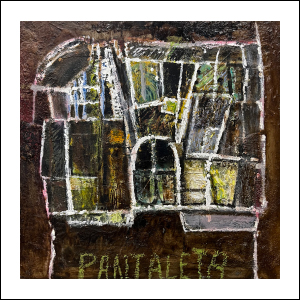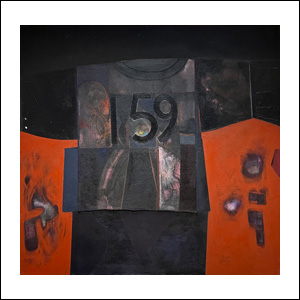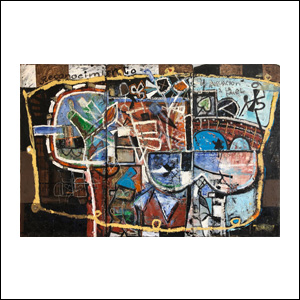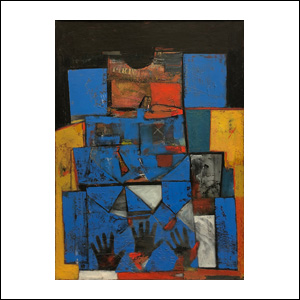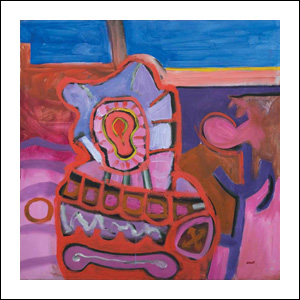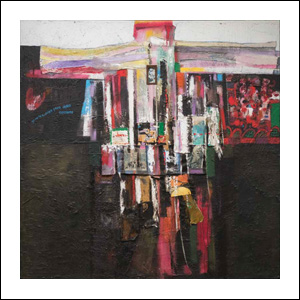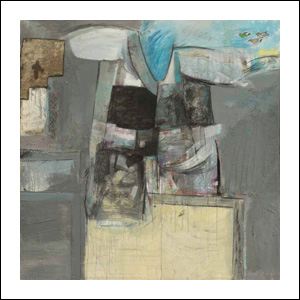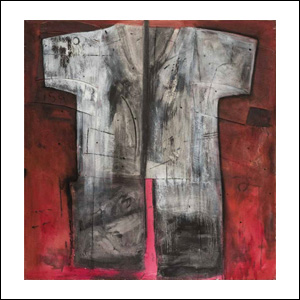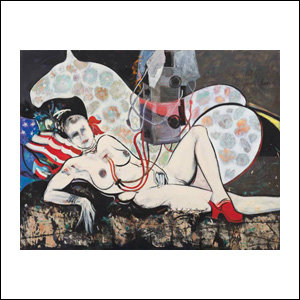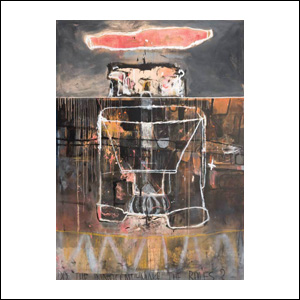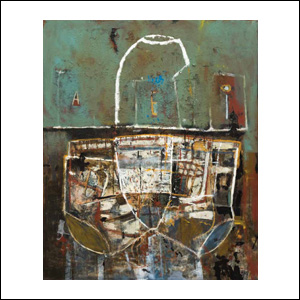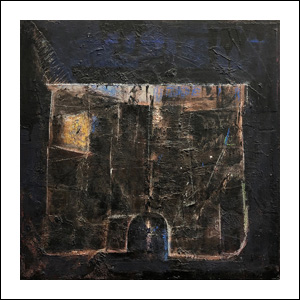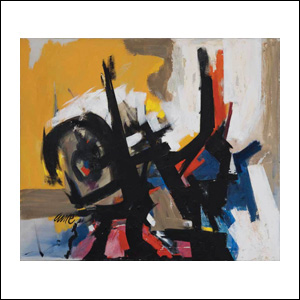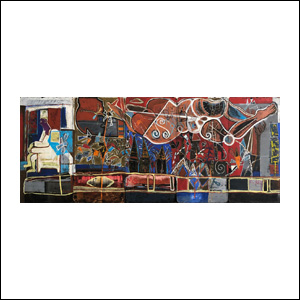Alberto Mijangos
Mexico City, 1925 - San Antonio, Texas, 2007
ALBERTO MIJANGOS - BIOGRAPHY
Alberto Mijangos was born on July 25, 1925 in Mexico City. His father, Alberto, was a native of Oaxaca, and his mother, Isabel Escobar, was a Spanish-descent aristocrat and opera singer from Ciudad Juarez, Chihuahua. Mijangos’s father, who had worked as a military paymaster during the Mexican Revolution, ran a thriving piano business, which began to fail in the early 1930s. Alberto Mijangos, his two sisters (Maria and Isabel), and his parents had to move from a luxurious home to a middle-class neighborhood. His embittered father, forced to take a job as a government bureaucrat, began to drink heavily. Alberto Mijangos after ending 6th grade was sent by his father to work in a post office. When he was fourteen years old his mother died and his father kicked him out of the house.
A strong childhood memory was having encountered Diego Rivera at work on his epic mural “The History of Mexico” (1929-35) at the Palacio Nacional in Mexico City; Mijangos recalls that, having run out of water, Diego Rivera used his own spit on the wall to mix the paint for his fresco. Mijangos learned that he liked to draw and decided to become an artist. He enrolled in the national fine arts school, the Academia de San Carlos, in Mexico City and studied for two years (1942-1943).
Mijangos left San Carlos to briefly serve in the Mexican Air Force. Subsequently he worked creating windows displays for store fronts in Mexico City. Even so, Mijangos felt the pull North towards a different life. He hitchhiked to Reynosa, crossed the river into Texas, where just outside of McAllen he picked oranges for three weeks, making at most $1.25 a day, while sleeping in a hole in the ground. He was deported from the United States numerous times, but persisted in crossing the Border.
Determined to achieve his dream of becoming an artist, the immigrant found work as a dishwasher in Edinburg, Texas. Intent on improving his situation, he worked on his English. He secured a small apartment where he painted portraits and bullfighting scenes. When Mijangos’ boss admitted that he was paying him less than the others for the same work simply because his Mexican origins, Mijangos quit on the spot. He traveled to Galveston, secured a job cooking in a restaurant, and painted decorative murals in local nightclubs.
After a year and a half in Galveston and with six dollars in his pocket, Mijangos took a bus to Chicago. He found work as a manager of a fast food restaurant where he was able to save enough money to enroll in painting and drawing classes at the Chicago Art Institute. He remained in Chicago for three years before accepting a friend’s invitation to help set up a photography studio in San Antonio, Texas. There, on a day in 1954, Mijangos met Luz (Lucy) Rodriguez, a San Antonio native, who had been hired to work in the studio. Shortly thereafter the FBI arrested Mijangos and deported him to Nuevo Laredo. Determined to return to San Antonio to marry Luz, Mijangos frequently wrote letters to the State Department explaining his intentions to marry an “American citizen,” and affirming his status as an artist; to his surprise, finally got a letter from the State Department saying they would give him the resident’s visa. He and Luz married on October 25, 1955 in San Antonio, Texas. Over the next decade their five children were born.
For three or four years in the mid-1950’s Mijangos worked for Joske’s Department Store at Commerce Street and Alamo Plaza doing displays from scratch and design. The job was, according to Mijangos, “better than art school” as he “learned to work with many materials… talented artists of all kinds, had good facilities and supplies and was given plenty of freedom to create with serious and wonderful themes. Joske’s advertising director, Caroline Shelton, encourage Mijangos and another Joske’s artist, Fred Kimsey, to open a new gallery at La Villita #506, The Art-Decor Gallery; Mijangos used the upstairs as his “Taller de Arte” painting studio.
Forming a friendship with the Mexican painter Raul Gamboa who directed the Mexican Art Gallery at the Mexican Consulate at 127 Navarro Street, Mijangos assisted Gamboa’s gallery work by translating Spanish texts to English. Upon Gamboa’s departure in 1959, Mijangos successfully interviewed with the Mexican Embassy officials to secure the position as Gamboa’s replacement, director of the Mexican Consulate’s Art Gallery. Receiving a diplomatic passport and the title of “Mexican Cultural Attaché,” Mijangos became instrumental in advancing Mexican President Adolfo Lopez Mateos’ efforts to renew Mexican cultural exchange with the United States. Mijangos worked under the supervision of Mexican cultural ambassador Miguel Alvarez Acosta, director of the Organismo de Promoción Internacional de la Cultura de Mexico (OPIC). Additionally, during the 1960s Mijangos was active in local arts organizations including the Men of Art Guild, which maintained a gallery at 8134 Broadway, the Contemporary Art Group, and the San Antonio Art League.
Mijangos’ tireless efforts in advancing San Antonio’s cultural exchange with Mexico were significant. Through the Mexican Consulate Mijangos facilitated bringing the exhibition “Arte de Mexico a través de los siglos / Mexican Art throughout the Centuries” to the Witte Museum in the summer of 1960; touted as “the largest temporary art show ever to be seen here, that will fill seven rooms of the museum.” Mijangos was further responsable for securing a collective exhibition at the Palacio de Bellas Artes in Mexico City in the summer of 1962 for San Antonio’s Men of Art Guild; he served as the president of this local arts organization from 1962-63. In July of 1965 another OPIC-organized exhibition, “9 Pintores contemporáneos de San Antonio, Texas” was presented at the Palacio de Bellas Artes.
In August of 1961 Mijangos painted a large-scale mural in the stairwell leading to a newly established library at his workplace, San Antonio’s Mexican Consulate. While the mural no longer exists, its reproduction in the San Antonio Light at the time recalls something of Rufino Tamayo’s approach to muralism where curving, sculptural, abstracted figures of man and woman are set against a vast skyscape energized by the sun.
Mijangos served as a consultant on the Expo HemisFair ’68 Committee for Cultural Affairs helping to plan San Antonio’s Worlds Fair, an International Exposition on the theme of “The Confluence of Civilizations in the Americas,” held from April to October 1968. At HemisFair’s conclusion, the City granted Mexico a 25-years lease on a series of buildings in HemisFair Park (today’s Yanaguana Garden) that had been used as pavilions in exchange for $1 symbolic rental. The Instituto Cultural Mexicano (Mexican Cultural Institute) an arm of the Mexico’s Ministry of Foreign Affairs was established. What had been the Mexican Pavilion would serve as exhibition halls and a 250-seat auditorium, while the surrounding buildings would be used for classrooms, language labs, offices, and a library. Additionally, the Institute would stand on “Plaza Mexico”, the construction of a 2100 square meter plaza designated by architect Roberto Felix, Director of Public Works of Zacatecas. Mijangos oversaw the placement of the reproductions of colonial arches and pre-Colombian monuments on the square to include two Atlantes of Tula and a colossal Olmec head. Alberto Mijangos, having been in the role of OPIC Gallery Director at the Mexican Consulate since 1960, was appointed the Institute’s first director. Mexico’s President Luis Echeverria and San Antonio Mayor John Gatti inaugurated Plaza Mexico and the Institute with a ribbon-cutting ceremony and festivities on June 20, 1972.
Another significant cultural exchange project that Mijangos coordinated under the auspices of OPIC was Our Lady of the Lake College’s annual Salute to Mexico, a week-long annual festival celebrating Mexico’s visual and performing arts that was initiated in 1967.
Crucial to Mijangos’ eventual commitment to abstraction would have been the exhibition Salon Independiente that he was instrumental in bringing to San Antonio in April of 1970 as part of the 3rd annual Salute to Mexico. This exhibition was presented at the newly established Mexican Cultural Institute at HemisFair Plaza, showing artworks by the most representative of Mexican abstract painters born in the 1920s and 30s, who formed the Ruptura group in the 1960s, including Lilia Carrillo, Enrique Echeverria, Manuel Felguerez, Gilberto Aceves Navarro, Brian Nissen, Ricardo Rocha, and Roger Von Gunten. Mijangos’ large-scale abstract paintings that he would produce in the 1980s clearly resonate with the aforementioned group of artists, his contemporaries working within abstract visual languages in Mexico.
Mijangos, who avoided recognizable Mexican imagery in his work, always maintained a Mexican identity. “I identify my self as I am. I am Mexican and number two I am Latino, but first I am Mexican.” When the Chicano movement in the arts emerged in the late 1960s, Mijangos was sympathetic to the cause even signing (or titling) several of his paintings “Con Safo,” a term that is urban and culturally specific to the Mexican-American experience.
Having served the Mexican Consulate for fourteen years (1959-1973) as an ambassador for cross-Border cultural exchange, Mijangos was devastated when he was fired from his job as director of the Mexican Cultural Institute. He felt into a deep depression, battled alcoholism, tried to commit suicide by overdosing on pills, separated from his wife and family, and ultimately moved to Oaxaca City where he remained for the next five years. There he established a summer arts institute in 1975. Rufino Tamayo, Mel Casas, and himself among a long list of specialists and university professors, comprised the faculty. Unfortunately the institute did not last too long because financial difficulties. He returned to San Antonio in 1979 and recovered from alcoholism. In 1983 Mijangos finalized his divorce from Luz Rodriguez, and one year later married Kay Karcher.
Mijangos started working in different series. The T-Shirt series was comprised of 200 plus paintings that he created over a twenty-year period starting in 1980. On Mijangos painting the t-shirt takes on religious meaning because of its cruciform shape. The artist further indicated that the cross form symbolized the personal sacrifices that everyone must make in their lives. Later Daniel Bennet, a collector of Mijangos art, relates: "The idea of where the t-shirt came from was something that we talked about because Alberto was interested in it, but he saw it as the shirt that was universal for everybody. It could be the cheapest thing, or it could be made expensive; it was symbolic of the simplest garment that anyone could have-a working class shirt. Then he would take that idea into one thinking of the lives of the people wearing them and their suffering. Then he thought of it more symbolically in his mind, ‘here is a shirt that is happy,’ If you look at his shirts you see that he is putting some emotion into it like burning it, or stabbing it, or cutting it, giving a life to it even though it is an inanimate object."
In 1990 Mijangos traveled to Europe visiting Spain, Italy, Switzerland, England, and France - his first visit to Paris, to the Louvre and the Musée d’Orsay, pushed Mijangos’ art in new directions. In 1991 Mijangos opened the Blue Door Studio at 818 Lexington Ave south of San Antonio College. He worked in the Olympia series, as Mijangos explains, this series uses Manet’s confrontational 19th Century Olympia as a springboard to examine “controversial situations in which we live today: political, social, economical and racial.”
In 1996 Mijangos formed a business partnership with Andy Benavides, opening Salon Mijangos and Benavides Picture Framing. He also taught advance painting at the Southwest School of Art from the late 1990s to early 2000s. At Salon Mijangos he built a community of students and began his large-scale Chónes (underwear) series, relating underwear to the secrets that humans hide, a theme that he explored up until his passing in 2007. Between 1999 and 2004 he produced a body of 53 paintings that he called the Tao Te Ching series; these specifically explore the inner terrain of darkness.
Mijangos, from his state of self imposed exile, is clearly representative of the Mexican Ruptura Movement both in his neo-figurative painting, as well as his figural abstractions (for just like Tamayo, Mijangos never quite completely abandoned the figure); moreover, viewed from US side of the Border, Mijangos is a highly contemporary, relevant, and even, a postmodern artist.
Alberto Mijangos died on June 19, 2007.
(Sources: Alberto Mijangos: 159, A Retrospective of His Art (and Life), by Dr. Teresa Eckmann, San Antonio Department of Arts and Culture, City of San Antonio, 2018)
ALBERTO MIJANGOS MAIN SOLO EXHIBITIONS
|
1964 Mel Casas and Alberto Mijangos, two-man exhibition, Men of Art Guild, San Antonio, Texas |
|
1982 Mexican Cultural Institute, San Antonio, Texas |
|
1986 San Antonio Art League selected Mijangos as the “Artist of the Year” and gave him a solo show at the Koehler Cultural Center, San Antonio, Texas |
|
1988 Mexican Cultural Institute, San Antonio, Texas |
|
1996 New Works, Milagros Contemporary Art, San Antonio, Texas |
|
1997 Silence, Mexican Cultural Institute, San Antonio, Texas |
|
2001 Permanent installation of the work “Christ on the Cross” at the Good Samaritan Service Center, San Antonio, Texas, which has been previously presented in the 1989 collective exhibition “Loaded” at the Blue Star Art Space with the title “Wet-back/T-Shirt-An Homage to the Illegal Worker.” Mijangos Explains: “I was an illegal, I crossed the river many times, and I knew these people who came from ranches and little towns… They have to work. They have to survive… They’re all over the world -illegal workers going from Spain to France, Mexico to the U.S. You have to take jobs that nobody wants to do, and you get paid a lower rate. You are confronting another culture. Many people die in the effort. Many people go mentally ill because of the cultural shock, and many people bleed on a daily basis. So this is an homage to the illegals in recognition of their value, their humanity.” |
|
2001 Trusting the Darkness, Tao Te Ching series, Southwest School of Art, San Antonio, Texas |
|
2003 Tao Te Ching series, Centro Cultural Universitario “Quinta Gameros”, Universidad Autónoma de Chihuahua, Chihuahua, Mexico |
|
2018 Alberto Mijangos: A Retrospective of His Art and Life, Centro de Artes, San Antonio, Texas. Presented by the City of San Antonio within its SA300 Tricentennial Celebration, curated by Dr. Teresa Eckmann. An exhibition catalog and monograph made by Dr. Teresa Eckmann was published and sponsored by the City of San Antonio Department of Arts and Culture and the University of Texas at San Antonio. |
|
2022 Alberto Mijangos: Transformative Power of Art, Mexican Cultural Institute, San Antonio, Texas |

